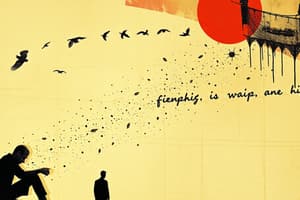Podcast
Questions and Answers
What is a notable feature of Punjabi literature?
What is a notable feature of Punjabi literature?
- Legal documents
- Epic poetry (correct)
- Vehicle manuals
- Cooking recipes
Which pronoun represents the third-person singular masculine in Punjabi?
Which pronoun represents the third-person singular masculine in Punjabi?
- ਉਹੀ (uhī)
- ਉਹ (uh) (correct)
- ਇਹ (ih)
- ਜੇ (je)
What literary genre is Bulleh Shah renowned for in Punjabi literature?
What literary genre is Bulleh Shah renowned for in Punjabi literature?
- Comedy plays
- Horror stories
- Science fiction
- Love poetry (correct)
What are common prepositions used in Punjabi for genitive and dative cases, respectively?
What are common prepositions used in Punjabi for genitive and dative cases, respectively?
Which type of narratives have Punjabi authors historically focused on?
Which type of narratives have Punjabi authors historically focused on?
What is the gender system in Punjabi?
What is the gender system in Punjabi?
What is a significant aspect of contemporary Punjabi literature?
What is a significant aspect of contemporary Punjabi literature?
How do Punjabi nouns change forms based on case and gender?
How do Punjabi nouns change forms based on case and gender?
What does verb conjugation in Punjabi depend on?
What does verb conjugation in Punjabi depend on?
Which word order does Punjabi typically follow?
Which word order does Punjabi typically follow?
How many tenses are included in the Punjabi verb conjugation system?
How many tenses are included in the Punjabi verb conjugation system?
In Punjabi literature, what is a common theme that is often explored?
In Punjabi literature, what is a common theme that is often explored?
Flashcards
Punjabi Language
Punjabi Language
An Indo-Aryan language spoken by over 100 million people worldwide.
Punjabi Genders
Punjabi Genders
Masculine and feminine. Applied to nouns and pronouns.
Noun Declension
Noun Declension
Nouns change form depending on case and gender.
Verb Conjugation
Verb Conjugation
Signup and view all the flashcards
Word Order
Word Order
Signup and view all the flashcards
Pronoun Usage
Pronoun Usage
Signup and view all the flashcards
Prepositions and Particles
Prepositions and Particles
Signup and view all the flashcards
Epic Poetry
Epic Poetry
Signup and view all the flashcards
Love Poetry
Love Poetry
Signup and view all the flashcards
Folklore
Folklore
Signup and view all the flashcards
Modern Literature
Modern Literature
Signup and view all the flashcards
Translations and Adaptations
Translations and Adaptations
Signup and view all the flashcards
Study Notes
Punjabi Language: Grammar and Literature
The Punjabi language, spoken by over 100 million people worldwide, is a vibrant and diverse part of South Asian culture. This article will delve into the intricacies of Punjabi grammar and the rich landscape of Punjabi literature, providing a snapshot of its unique features.
Punjabi Grammar
Punjabi is an Indo-Aryan language, belonging to the Indo-European family. It employs a rich, yet straightforward grammar system, that often contrasts with English grammar. Some of its notable features include:
-
Gender system: Punjabi has two genders: masculine (ਮਸਲੀ, masali) and feminine (ਫੁਲਰੀ, phulari). This system is primarily applied to nouns and pronouns.
-
Noun declension: Punjabi nouns undergo declension, altering their form depending on case and gender. For instance, the word for 'book' (ਕਤੇਬ, kateb) in the nominative case (subject) is ਕਤੇਬ, while in the genitive case (possessive) it becomes ਕੇਤੇਬ ਦਾ (keteb dā).
-
Verb conjugation: Punjabi verbs are conjugated based on tense, aspect, mood, and person. The tense system includes past, present, and future, while the aspect (completed or ongoing) and mood (indicative, imperative, etc.) further modify the verb form.
-
Word order: Punjabi, like many other Indo-Aryan languages, follows a subject-verb-object (SVO) word order. However, the language exhibits a high degree of flexibility, and variations in word order are frequent.
-
Pronoun usage: Punjabi pronouns follow a complex system based on gender, person, and case. For example, the third-person singular masculine pronoun is ਉਹ (uh), while the third-person singular feminine pronoun is ਉਹੀ (uhī).
-
Prepositions and particles: Punjabi employs prepositions and particles to connect words, phrases, and clauses. Common prepositions include ਦਾ (dā) for genitive (possessive) case and ਦੀ (dī) for dative (indirect object) case.
Punjabi Literature
Punjabi literature boasts a rich and diverse heritage, spanning thousands of years. The written history of Punjabi literature dates back to the 15th century, with major works appearing during the 18th and 19th centuries. Notable features of Punjabi literature include:
-
Epic poetry: Works such as the Raghubans (18th century) and Raggaranth (19th century) are based on historical and mythological narratives, depicting the lives, deeds, and sacrifices of heroic figures.
-
Love poetry: Punjabi love poetry, particularly by the Sufi poet Bulleh Shah, is renowned for its depth, mystery, and philosophical insights.
-
Narrative prose: Historically, Punjabi authors have penned numerous narratives, including Balmiki Ramayan (16th century) and Bābā Būrj Gantbār (19th century).
-
Folklore: Oral storytelling remains prevalent in Punjabi culture, with tales of spirits, magic, and heroism continuing to be passed down through generations.
-
Modern literature: Contemporary Punjabi literature is influenced by various genres, including poetry, prose, and drama, and explores a diverse range of themes, from social issues to personal identity.
-
Translations and adaptations: Punjabi literature has been translated and adapted into various languages, fostering cross-cultural understanding and appreciation.
In conclusion, Punjabi language and literature offer a rich tapestry of cultural heritage, intricate grammar, and evocative narratives. Understanding the foundations of Punjabi grammar and exploring its diverse literary landscape provides a window into South Asian culture, language, and history.
Studying That Suits You
Use AI to generate personalized quizzes and flashcards to suit your learning preferences.




